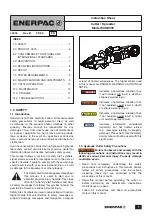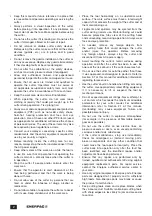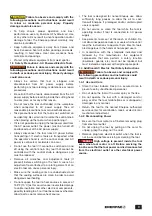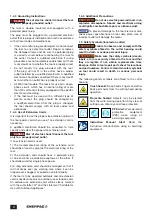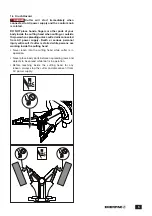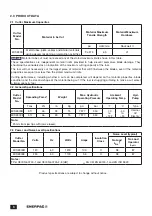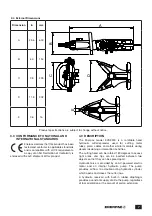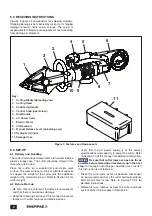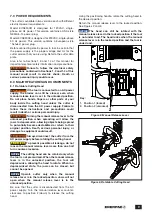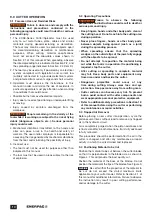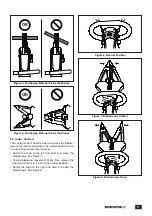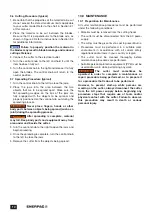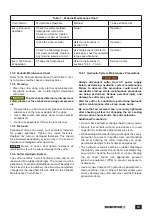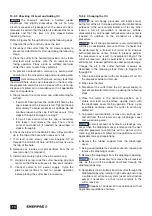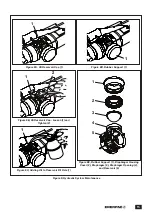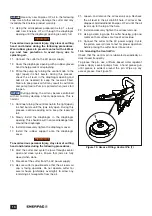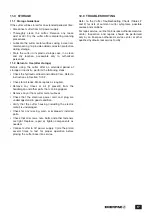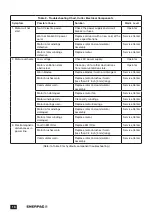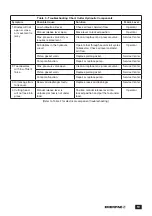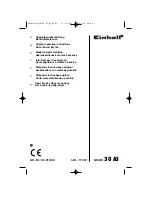
13
10.2 Periodic Maintenance Chart
Refer to the Periodic Maintenance Chart (Table 1) for a
list of various routine checks and procedures.
10.3 Cleaning
• Clean the cutter using a dry cloth or compressed air.
For plastic surfaces, use a cloth slightly dampened
with water.
NOTICE:
CAUTION
To prevent possible injury, always wear
safety glasses or face mask when using compressed
air.
• Be sure there are no traces of oil, grease or corrosive
substances on the tool, especially on the grips.
• Use a damp cloth and soapy water to clean plastic
components.
• Do not use gasoline or thinner to clean the tool.
10.4 Fasteners
Periodically check all screws, nuts and other fasteners
for proper tightness. Tighten any loose fasteners.
Replace any worn or damaged fasteners. This should
be performed periodically or every day in the event of
frequent or prolonged cutter operation.
NOTICE
Failure to check and tighten fasteners as
required may result in serious damage to the cutter.
10.5 Cutter Hydraulic System
The cutter contains a small hydraulic pump and an oil
reservoir with a rubber diaphragm. The oil level must be
periodically checked and additional oil must be added if
the oil level is low. In addition, the oil must be completely
changed at the specified interval. Refer to the Periodic
Maintenance Chart (Table 1).
Table 1 - Periodic Maintenance Chart
Time Interval
Maintenance Operation
Method
To be performed by:
Every 8 hours of
operation:
Check the cutter for loose,
damaged or worn parts.
Check for oil leaks. Tighten,
replace or repair as required.
Visual
Operator
Clean the cutter exterior.
Refer to instructions in
Section 10.3.
Operator
Check the tightening torque
of screws and bolts. Replace
any missing screws or bolts.
Use torque wrench. Refer to
repair parts sheet for complete
torque specifications.
Operator
Every 1600 hours
of operation:
Change the hydraulic oil.
Refer to instructions in
sections 10.5.1 - 10.5.3.
Service Center
10.5.1 Hydraulic System Maintenance Precautions
NOTICE:
WARNING
Always disconnect cutter from AC power supply
before performing hydraulic system maintenance.
Failure to observe this precaution could result in
accidental start-up while maintenance procedures
are being performed. Serious personal injury and
damage to cutter may result.
Wait for cutter to cool before performing hydraulic
system maintenance. Hot oil can cause burns.
Be sure that oil reservoir cap is securely tightened
after checking oil level or changing the oil. Leaking
oil can cause short circuits, fire and explosions.
Additional Precautions:
• Do not check oil level or change the oil in dusty areas.
• Be sure that all tools (wrench, screwdriver, etc.) used
to perform maintenance procedures are clean.
• When adding oil and performing oil changes, take every
precaution to prevent impurities from contaminating
the oil or entering the cutter. Impurities can cause
permanent damage to the hydraulic components.
• The hydraulic reservoir contains a rubber diaphragm
that slightly pressurizes the oil. Some oil spillage may
occur when checking the oil level or when changing
the oil. Wear and/or use appropriate personal
protective equipment (PPE) to prevent exposure to
hydraulic oil.
• Use only new Enerpac HF hydraulic oil poured from a
clean container. Use of other oil brands and/or used
oil may damage the cutter and may void the Enerpac
product warranty.
Summary of Contents for ECSE300
Page 20: ...WWW ENERPAC COM...

